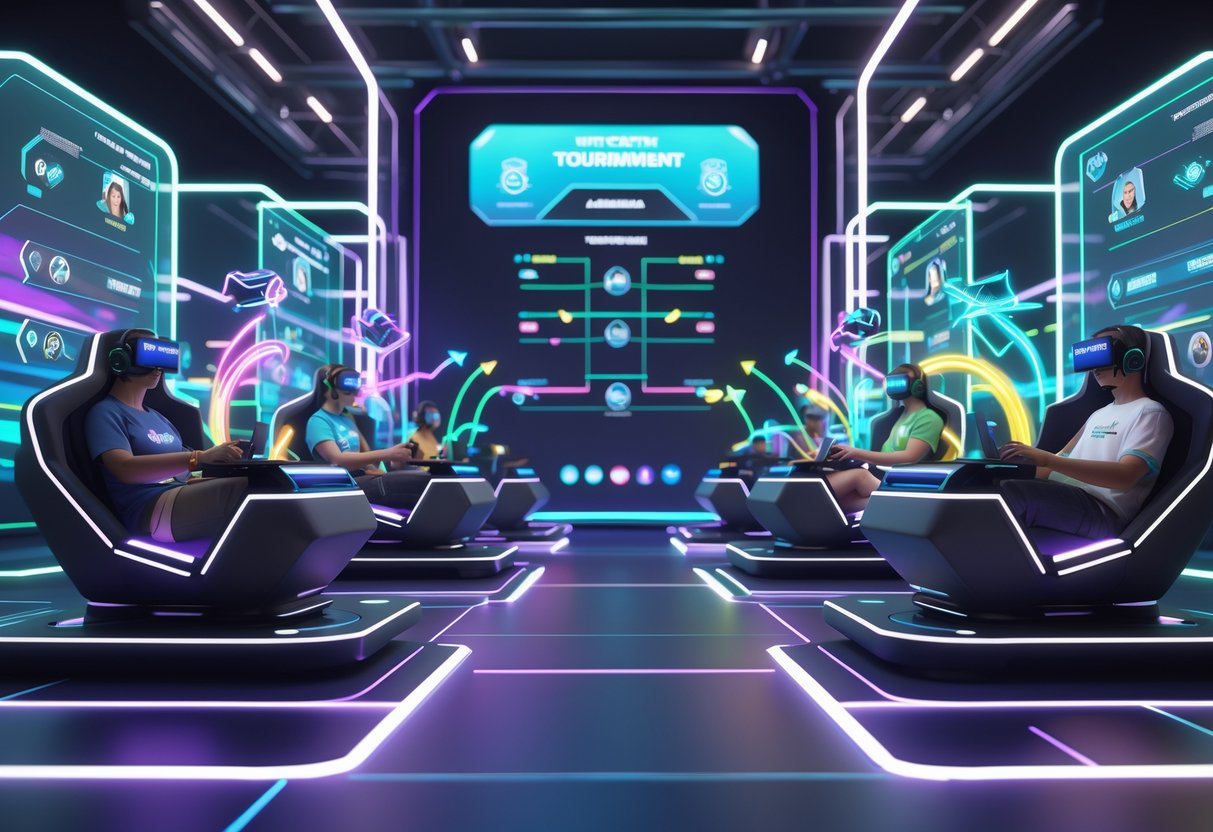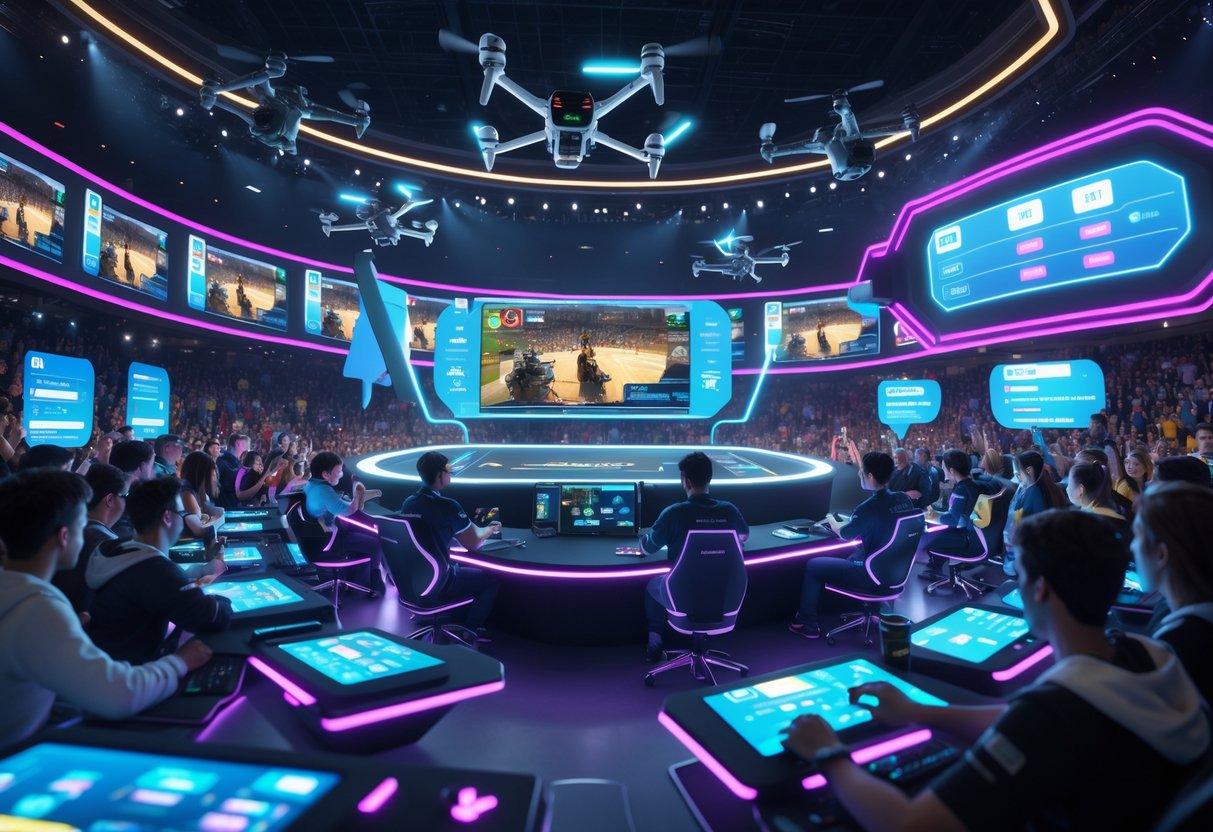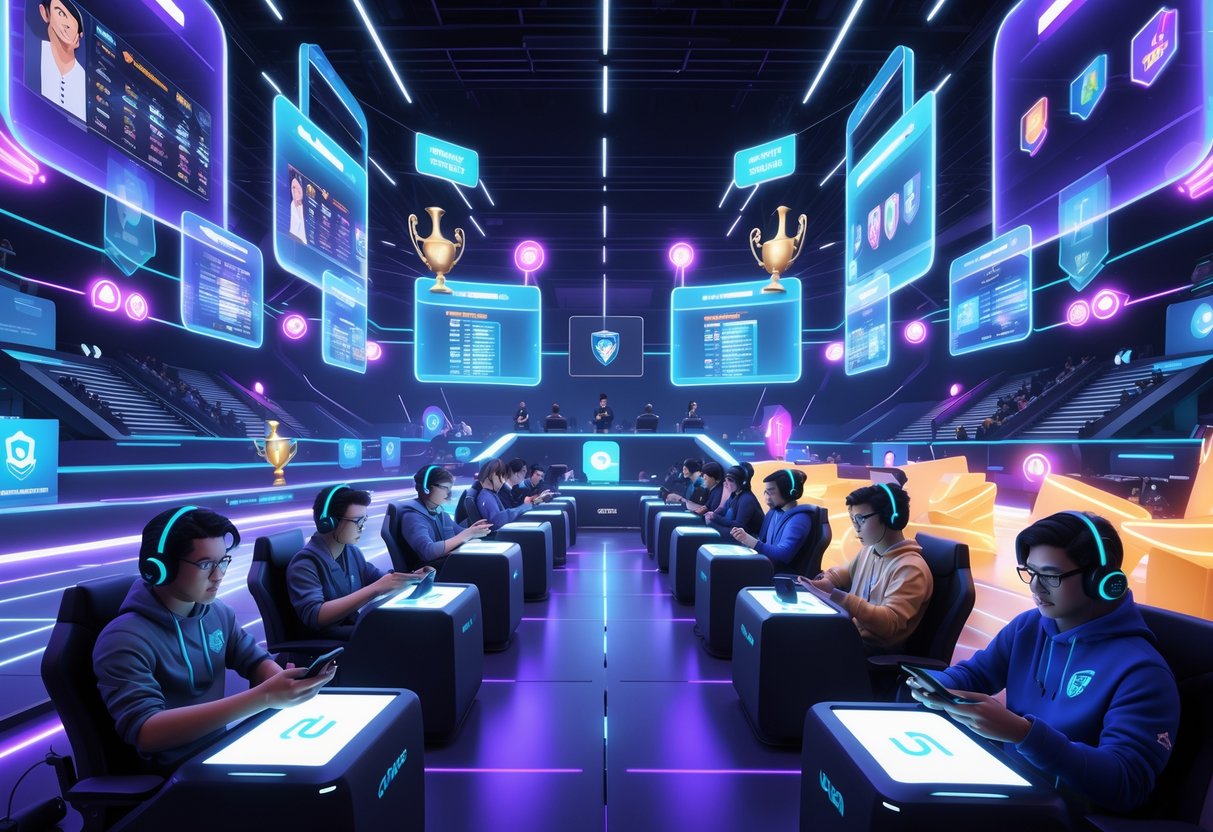Mobile Gaming Tournament Formats: A Deep Dive into Competitive Structures
Updated On: November 12, 2025 by Aaron Connolly
Core Tournament Formats for Mobile Gaming

Mobile esports tournaments usually rely on three main bracket systems to determine who advances and who gets knocked out. Each format tries to strike a balance between fairness, time constraints, and viewer excitement.
Single Elimination Structures
Single elimination brackets feel a lot like knockout cups in football. Lose once, and you’re out.
This format just fits mobile gaming. Most mobile esports events need quick results since people have shorter attention spans and want to watch on the go.
Key characteristics:
- Teams get one shot—win or go home
- Winners move forward, losers exit
- Matches usually run as Best of 3 (BO3)
- Fewer rounds to finish the tournament
PUBG Mobile and Free Fire love single elimination for major championships. The pressure is wild and makes for some really intense matches.
Advantages for mobile esports:
- Fast tournaments suit mobile viewing
- High stakes mean more drama
- Bracket’s simple—easy to follow on a phone
- Organisers save money and time
But there’s a downside: strong teams sometimes get knocked out early after just one unlucky game. Battle royale titles especially see this since luck matters more than in other esports.
Double Elimination Approaches
Double elimination gives teams a second shot by splitting things into two brackets. Teams start in the upper bracket, and if they lose, they drop to the lower bracket instead of going home.
Skill-based games like Mobile Legends and Arena of Valor use this a lot. It helps the best teams reach finals but still keeps things unpredictable.
How it works:
- Upper bracket winners keep advancing
- Losers from the upper bracket drop to the lower one
- If you lose in the lower bracket, you’re out
- Grand finals bring together the winners from both brackets
The lower bracket brings out some great stories. Teams claw their way back, sometimes creating the most memorable moments of the tournament.
Mobile gaming benefits:
- Helps offset technical issues (think connection drops or device hiccups)
- Shows who’s actually best
- More matches for streaming and content
- Upset teams get to prove themselves
Organisers have to plan for a lot more matches, though. The lower bracket can be almost as long as the main one, so scheduling gets tricky.
Swiss System Adaptations
Swiss systems pair up teams with similar records each round. No one gets eliminated until all rounds finish.
This setup works well when you’ve got tons of teams. Many mobile tournaments start with hundreds of squads, so traditional brackets just don’t cut it.
How Swiss works:
- First round is random or seeded
- Next rounds: teams with the same record face off
- Runs for a set number of rounds (usually 5-7)
- Top teams move on to knockout playoffs
Where it fits mobile esports:
- Open qualifiers with lots of teams
- Regional championships over several countries
- Amateur tournaments on mobile platforms
- University mobile esports leagues
The Rocket League Championship Series uses Swiss really well, but most mobile games go for shorter formats—time is always tight.
Why it works:
- Every team knows they’ll play a certain number of matches
- Fairer than pure elimination for figuring out skill
- Handles connection issues better than brackets
- Naturally creates skill tiers
Swiss systems are popular for leagues and amateur events since teams know exactly what to expect.
Group Play and Round-Robin Systems
Group play and round-robin setups let every team face all their group opponents. This structure keeps things fair and stops strong teams from knocking each other out too soon.
Typical Round-Robin Implementation
Mobile tournaments often use round-robin by putting teams into groups of 4-6. Every team plays everyone else in their group once.
Standard group setups:
- 4 teams = 6 matches per group
- 6 teams = 15 matches per group
- 8 teams = 28 matches per group
Teams earn points for wins and draws—usually 3 for a win, 1 for a draw, 0 for a loss.
The top 2-4 teams in each group move on to knockouts. This hybrid system tests everyone but still brings the excitement of elimination rounds.
Quick tip: Lots of tournaments run several round-robin groups at the same time. It saves time and keeps things fair.
Benefits and Drawbacks of Group Play
Round-robin formats give teams more chances to prove themselves. One bad game doesn’t end your run.
Main benefits:
- Fairer way to judge team skill
- More matches for fans to watch
- Less luck involved compared to single elimination
- Teams can bounce back after early losses
But these systems take a lot of time. A 6-team group needs 15 matches, which can stretch out tournaments for days.
Common issues:
- Longer tournament duration
- Higher costs for venues and logistics
- You sometimes get “dead” matches when teams have already qualified
- Not as tense as knockout brackets
Heads up: Some teams might play it safe in their last group matches if they’ve already qualified. That can make things a bit boring.
Battle Royale and Free-for-All Formats
Battle royale tournaments throw dozens of players or squads into the mix at once—only one winner comes out each match. Scoring usually mixes placement points with elimination counts, which just fits games like PUBG Mobile and Call of Duty Mobile.
Battle Royale Tournament Mechanisms
Battle royale tournaments don’t use traditional brackets. Instead, 60-100 players all compete at the same time in each game.
Most mobile esports tournaments run several matches per round. Players rack up points over 3-6 games instead of just one. This helps balance out bad luck from early-game mishaps.
Tournament structure options:
- Single-day events with 4-6 matches
- Multi-day events with qualifiers
- League formats that run for weeks or even months
Free-for-all formats look similar but usually have fewer players. Racing and party games often use this, with 8-20 players per match.
Unlike traditional brackets, lots of teams can score points in each game. Even if you finish 5th, you still get points—getting knocked out doesn’t mean you’re done.
Ranking and Scoring Methods
Mobile battle royale tournaments use point systems that reward both survival and being aggressive. Placement points plus elimination bonuses are the norm.
Standard scoring might look like:
- 1st place: 10 points
- 2nd place: 6 points
- 3rd place: 5 points
- 4th-10th: 4-1 points
- Each elimination: 1 point
Some events use multipliers, so higher placements make kills worth more. First place teams might get 1.5 points per kill, while others just get the standard.
Placement-only scoring works for games where tracking eliminations is tough. Auto-chess style games do this a lot. Organisers sometimes use raw points to keep things simple.
Quick win: Most mobile tournaments show live leaderboards, so everyone knows where they stand after every match.
Noteworthy Games and Use Cases
PUBG Mobile basically owns mobile battle royale esports. Big events like the PUBG Mobile Global Championship rely on placement-plus-kill scoring over several days.
Call of Duty Mobile runs both battle royale and regular multiplayer tournaments. The battle royale format is easier for casual fans to follow—there’s just more chaos and more to watch.
Garena Free Fire is huge in Southeast Asia and Latin America. Its short matches (about 10 minutes) fit mobile events with tight schedules.
Racing games work great with free-for-all setups. Mario Kart Tour and similar titles run tournaments where players race across different tracks, adding up scores.
Party games like Fall Guys Mobile use elimination-style free-for-all. Players drop out each round until someone wins. It’s tense and a lot of fun to watch.
Heads up: Battle royale tournaments need more technical support than regular brackets. Organisers have to track 20+ teams at once, which can get messy.
Best-of Match Types Explained
Mobile tournaments play around with match lengths to balance fairness and time. Bo3 formats let players show off their skills, but best-of-one matches keep things moving—super important for mobile’s quick pace.
Best-of-One and Best-of-Two
Best-of-one (Bo1) matches are just one game—win and you move on, lose and you’re out. Mobile tournaments love Bo1 since games like Clash Royale only last a few minutes.
Bo1 is great for:
- Early rounds with lots of teams
- Mobile games with short matches
- Weekend events needing to wrap up fast (tight schedules)
Best-of-two formats don’t show up much in mobile esports. Teams play two games, and if it’s 1-1, tiebreakers like total damage or fastest win decide it.
Most tournaments just skip Bo2. Too many ties, not enough clear winners. You’ll mostly see Bo2 in league formats where teams collect points over several weeks.
Tip: Bo1 matches bring more upsets. Lower-tier teams can surprise favorites with a single win.
Best-of-Three in Mobile Tournaments
Best-of-three (Bo3) is the sweet spot. You need two wins to advance, so players get a chance to adapt and recover from early mistakes.
Bo3 perks:
- Players can change strategies between games
- Luck or technical issues matter less
- Comeback stories happen more often
- Still works for weekend tournaments
PUBG Mobile and Free Fire use Bo3 for playoff rounds a lot. A typical Bo3 in PUBG Mobile might last 45-75 minutes, breaks included.
Organisers often mix formats—Bo1 for groups, then Bo3 for knockouts. It keeps things fast early on but makes finals more competitive.
Warning: Bo3 matches can wear players out. By the third game, finger fatigue and eye strain start to show.
Best-of-Five and Finals Formats
Best-of-five (Bo5) is usually just for the biggest finals. Teams need three wins, and matches can stretch to 2-3 hours.
Big mobile tournaments like PUBG Mobile Global Championship go Bo5 for grand finals. This really lets teams prove who’s best.
Bo5 things to keep in mind:
- Viewers need to commit a lot of time
- Players get tested mentally and physically
- More time for ads and sponsors
- Map or mode selection can matter a lot
Some events try Bo7 for world finals, but that’s rare. Mobile fans generally prefer shorter, more frequent matches over long marathons.
Typical format progression:
- Group stage: Bo1
- Quarter-finals: Bo3
- Semi-finals: Bo3
- Grand final: Bo5
This way, tournaments stay competitive but don’t drag on too long.
Participant Structures and Team Setups

Mobile esports tournaments usually pick from three main participant setups. Individual duels test solo skill, team competitions focus on coordination, and hybrid formats mix things up for more variety.
1v1 and Duel Formats
Individual mobile esports really stand out in games like Clash Royale and Brawl Stars duels.
These tournaments throw one player against another, head-to-head.
Most mobile 1v1 tournaments run on single-elimination brackets.
Players move forward by winning matches, and only one makes it to the end.
This setup keeps events short and, honestly, pretty thrilling.
Quick win: Try entering smaller 1v1 mobile tournaments first—it’s a good way to build confidence before you jump into the big leagues.
Common 1v1 mobile games include:
- Clash Royale (strategy card battles)
- PUBG Mobile solo matches
- Street Fighter: Duel fighting tournaments
- Chess.com mobile championships
Getting started is simple.
You just need the game installed, a solid internet connection, and to register through the tournament platform.
Prize pools can be modest or massive.
Local events might offer £50, while major mobile esports tournaments can go above £10,000.
Most 1v1 formats wrap up in 2-4 hours.
Team-Based Tournament Structures
Team mobile esports take the spotlight in games like PUBG Mobile and Mobile Legends.
Teams usually have 3-5 players who need to communicate and plan together.
Standard team sizes by game:
- PUBG Mobile: 4 players (squad format)
- Mobile Legends: 5 players (MOBA standard)
- Call of Duty Mobile: 5 players (Battle Royale teams)
- Brawl Stars: 3 players (team modes)
Teams sign up together and stick with the same roster through the tournament.
Most tournaments only allow substitutions for emergencies.
Communication is crucial in team play.
Competitive teams almost always use Discord or in-game voice chat during matches.
Practice sessions really help with team synergy and timing.
Team tournaments often start with group stages, then move into knockout rounds.
This way, all teams play several matches before anyone gets eliminated.
Mixed and Hybrid Formats
Hybrid mobile tournaments mix solo and team play.
Players might go solo for qualifiers, then team up for the finals.
Battle royale games are perfect for these formats.
Players compete alone in early rounds, then join squads for the big stages.
Common hybrid structures include:
- Solo qualifiers → team finals
- Rotating individual/team rounds
- All-star exhibitions that mix it up
- Skills challenges alongside the main event
Gauntlet tournaments can shake things up.
Lower-seeded players fight through solo matches, while top teams jump in later.
Some mobile esports tournaments even feature multiple game modes.
Players might compete in both solo and team versions of a game, and their results combine for final rankings.
Warning: Hybrid formats take more time.
Expect to spend 6-8 hours over a couple of days, not just a single session.
These mixed approaches keep tournaments lively and test a range of skills.
They’re especially popular in mobile esports since many games naturally support different player counts.
Prize Pools and Rewards Distribution

Mobile esports tournaments in 2025 come with prize pools that range from £1,000 at local events to a wild £3 million for world championships.
Organisers usually use percentage-based distribution, so top finishers get the biggest rewards, but plenty of teams still walk away with something.
Types of Prize Pools in Mobile Esports
Winner-takes-all pools hand the entire prize fund to the champion team.
This works for smaller or head-to-head events, but it can scare off teams in bigger tournaments—most folks know they probably won’t win first.
Percentage-based distribution is the go-to for pro mobile esports.
The top team gets about 30-40% of the total pool, with less for each spot below.
For example, a £100,000 tournament might split £35,000 to first, £20,000 to second, and £12,000 to third.
Flat-rate systems pay out fixed amounts for each placement.
You might see £10,000 for first, £5,000 for second, and £2,500 for third, no matter the total pool.
Big titles like PUBG Mobile and Call of Duty Mobile stick with tiered systems.
COD Mobile’s 2025 season keeps a £1 million prize pool across events, and PUBG Mobile’s PMWC splits £3 million among 28 teams.
Rewarding Systems for Winners and Participants
Top-tier rewards go beyond just cash.
Winners snag championship trophies, exclusive in-game items, and often land sponsorships that can be worth more than the prize money itself.
Participation rewards mean teams don’t leave empty-handed.
Many tournaments offer travel stipends, merch, or smaller cash prizes for those outside the top spots.
This keeps more teams coming back, making the scene stronger.
Performance bonuses reward standout moments.
Teams might score extra cash for most eliminations, best individual plays, or fastest wins.
These little rewards keep the energy up, even if the big prize is out of reach.
Regional qualification prizes give teams another way to earn.
Teams can win money just by making it into major events, so there are more ways to cash in during a season.
Grassroots and Amateur Tournament Pathways

Local tournaments are really the starting point for mobile esports careers.
They make it easy for new players to get involved and connect community-level play to pro opportunities through organised amateur leagues.
Entry-Level Competition Structures
Tournament organisers at the grassroots level keep things open and friendly.
Anyone can sign up, and there’s no intimidating barrier to entry.
Community centres, schools, and gaming cafes usually host these events.
Entry fees are low—sometimes free, rarely more than £10-20.
Popular entry-level formats include:
- Single elimination brackets (quick and fun)
- Swiss system rounds (everyone gets multiple games)
- Round robin groups (guaranteed matches for each player)
Games like PUBG Mobile and Clash Royale rule these local tournaments.
Organisers often run best-of-one matches in group stages so more people can play.
Plenty of organisers offer practice sessions before the competition.
These help first-timers get comfortable with the format and rules.
Quick win: Try searching “mobile esports [your city]” on Facebook.
You’ll probably find a local tournament group pretty quickly.
Local tournaments usually give out gaming vouchers or accessories as prizes, not big cash.
Honestly, the best reward is the experience and meeting other players.
Transitioning from Amateur to Professional Play
Moving from local tournaments to pro mobile esports takes steady results and smart planning.
Regional leagues bridge the gap between amateur and pro.
Key progression stages:
- Top 3 finishes at local tournaments
- Competing in regional qualifiers
- Getting noticed and picked up by semi-pro teams
- Qualifying for the professional circuit
Most top players spend 6-12 months playing locally before they try their luck at regional events.
That gives them time to build skills and get used to tournament pressure.
PUBG Mobile makes the amateur path pretty clear.
Their 2025 roadmap opens more doors for amateur players to reach international competitions.
Semi-pro teams watch regional tournaments for new talent.
If you’re consistently finishing in the top five, team managers will notice.
Warning: Watch out for organisations that want upfront payments for “pro training”—real teams invest in you, not the other way around.
The mobile esports market hit $2.4 billion in 2024, so there are more pro opportunities out there than ever.
Still, less than 1% of amateur players actually turn pro.
Focus on sharpening your core skills and really learning the tournament formats at the grassroots level.
That’s where a solid foundation starts.
Regional and International Tournament Hierarchies

Mobile esports tournaments follow a clear ladder.
Local and regional competitions feed into major international championships, so the best teams from every area get a shot at the top.
Regional Leagues and Qualification Events
Regional leagues form the backbone of mobile esports.
These tournaments run year-round in different regions.
The Mobile Legends Professional League (MPL) operates in places like Southeast Asia, Brazil, and other key markets.
Each region has its own season, and local teams battle for the regional crown.
Call of Duty Mobile expanded to six regions in 2025:
- North America
- Europe
- India
- LATAM
- Japan
- Africa
Regional events act as qualification pathways for international tournaments.
Teams have to perform well at home before they can go global.
Most regional leagues run a regular season followed by playoffs.
This gives teams several chances to prove themselves, not just a single-elimination shot.
Prize pools at the regional level usually sit between £10,000 and £100,000, depending on the game and the region.
International Championships and Their Formats
International championships bring together top teams from each region.
These events are the peak of mobile esports.
The Mobile Legends World Championship features 16 teams from all over, competing in Jakarta.
Teams qualify by doing well in their regional MPL or through special qualifiers.
Tournament structures at this level usually look like:
- Group stage: Teams split into groups and play round-robin
- Playoffs: Single or double-elimination brackets
- Grand finals: Best-of-five or best-of-seven series
International events often use Swiss format or GSL groups to balance matchups.
This way, the strongest teams won’t knock each other out too early.
Prize pools can go over £500,000, and some hit £1 million or more.
Events like the Mobile Legends World Championship offer life-changing money for winning teams.
Organisers stream these tournaments on YouTube, Twitch, and regional services to reach fans everywhere.
Innovative and Emerging Tournament Formats

Mobile gaming tournaments are getting creative with hybrid events that blur the line between online and offline play.
Organisers keep experimenting with new scoring systems and elimination styles to make matches even more interesting.
Hybrid Online-Offline Events
Hybrid tournaments blend the perks of digital and live competition.
Players compete online for qualifying rounds, then meet up at live venues for the finals.
Why does this work so well for mobile games?
- Players stick with their own devices during online stages.
- Only the top players need to travel, which keeps costs down.
- It opens the door for more players from different regions.
A lot of organisers now use a 75% online, 25% offline split.
Most rounds happen remotely, but the finals are live.
Key benefits:
- Easier for new players to join in
- More audience engagement at live finals
- Lower overall tournament costs
Some tournaments even let players pick their format—online all the way if they want, or live finals for those who love the crowd.
Experimental Scoring and Elimination Methods
Traditional single or double elimination brackets are starting to feel a bit old-school.
Now, more tournaments are trying out creative systems to keep players involved longer.
Popular experimental formats:
- Swiss system: Players face others with similar records
- Battle royale brackets: Multiple teams get knocked out each round
- Point accumulation: Rankings reward consistent performance
The Swiss system has become a favorite.
Players get several matches, even if they lose early.
Scoring innovations:
- Points for performance, not just wins
- Comeback bonuses for teams that bounce back after losses
- Viewer voting that tweaks minor scores
These ideas help stop early exits from ruining the fun but still keep things competitive.
Fan Engagement and Broadcasting Features

Modern mobile tournaments are all about interactive experiences.
Organisers now turn viewers into active participants and make sure broadcasts work smoothly on every device.
They’re packing in real-time engagement tools and mobile-friendly streams to create that festival vibe that keeps fans locked in throughout the competition.
Interactive Viewer Experiences
Mobile gaming tournaments these days? They’re way more than just sitting back and watching. Organizers now toss in real-time polls during matches, so viewers can predict winners or cheer for their favorite plays.
Plenty of events hand out achievement badges and digital collectibles for fans who actually get involved. You earn them just by participating, which is honestly pretty fun.
Gamification elements pull viewers in deeper. Fans unlock special content by hitting certain viewing milestones or chatting during matches. Some tournaments even set up reward systems—watch enough, chat enough, and you rack up points for merch or tickets to future events.
Multi-angle viewing? That’s a game-changer. On your phone, you can flip between player perspectives, which gets especially wild in battle royale tournaments. Following multiple teams at once feels super immersive.
With social media integration, sharing highlights or those in-game achievements is instant. Fans make clips straight from the mobile stream and blast them out on their socials, which helps tournaments grow without much effort.
Heads up: If a tournament tries to charge you for basic interactive features, maybe skip it. The good ones offer the essentials for free.
Live Streaming and Mobile-Friendly Viewing
Cross-platform compatibility matters if you want everyone to tune in. We always look for events that stream on Twitch, YouTube, and Facebook Gaming, and still keep high-quality video playback smooth on phones.
Low-latency streaming makes a huge difference. Nobody wants a big delay, right? These days, top tournaments keep it under 10 seconds, so chat actually feels live when things get tense.
Customisable notifications are a must. Good tournament apps let you pick your favorite teams or players, then ping you when matches start or results drop.
Offline viewing capabilities come in handy too. Tons of tournaments now offer mobile-optimised highlights and downloadable replays—perfect if your signal is spotty.
Data-efficient streaming helps out fans with limited data. Look for events that let you swap between video quality levels, so you don’t burn through your plan just to watch a match.
Quick tip: Try out a tournament stream on your phone before the big event. Saves you from last-minute headaches.
Mobile Esports Ecosystem and Popular Titles

Mobile games have really shaped how tournaments run. Each game comes with its own style and technical quirks, so formats end up pretty varied.
Battle royale titles need totally different setups compared to classic MOBAs. PC and console esports still influence mobile events, but the scene keeps shifting.
Impact of Specific Games on Format Choices
PUBG Mobile basically flipped mobile esports on its head. Battle royale matches last longer, so organizers tweak best-of-3 formats to fit those 20-minute games. It’s a big change from the old 5-minute matches.
Mobile Legends: Bang Bang sticks with MOBA traditions—best-of-5 series rule the big tournaments. The fast matches mean fans can enjoy long series without burning out.
Call of Duty: Mobile mixes it up by blending different game modes in one tournament. Organizers usually go with best-of-5 formats, mixing in Search and Destroy, Team Deathmatch, and Hardpoint.
Arena of Valor loves best-of-7 series, mostly because their matches last about 15 minutes. More games, more hype, and it keeps the competition fair.
Clash Royale does things differently—unique brackets and best-of-5 ladders. Each game is only three minutes, so they can cram a bunch of matches into a single day.
Influences from Other Esports Genres
PC gaming formats definitely leave their mark on mobile events. Counter-Strike made best-of-3 series popular, and now you see them everywhere in mobile FPS tournaments.
Traditional sports broadcasting changed how mobile esports schedule games. Group stages often use Swiss-system formats, which actually come from chess.
League of Legends brought in seasonal leagues, and now mobile games run regular seasons with playoffs too.
Fighting game communities gave us double-elimination brackets. Mobile fighting games jumped on that for fairer competition.
Battle royale PC games started the whole lobby-based competition thing. Mobile games picked it up, but swapped out single-elimination for heats and point systems.
Frequently Asked Questions
Mobile gaming tournaments use all kinds of formats to keep things fair and manageable. You’ll see everything from quick knockout brackets to round-robins where every team battles every other team.
What are the different types of tournament formats used in mobile gaming competitions?
You’ll mostly run into four main formats. Single elimination is the fastest—lose once, and you’re out.
Double elimination gives you a second shot. There are winner and loser brackets, so you need to lose twice before you’re done.
Round robin means every team plays all the others. It takes longer, but it’s the best way to see who’s really on top.
Swiss system tournaments pair winners with winners and losers with losers. No one gets eliminated, and you play a set number of rounds.
How does a round robin tournament work in the context of esports?
In round robin, every team faces every other team at least once. If there are 8 teams, each plays 7 matches.
There are no sudden eliminations. Organizers use leaderboards to track standings, which helps strong teams avoid early exits from random upsets.
Mobile games like Mobile Legends and PUBG Mobile use round robin for small qualifiers. It works best with fewer than 20 teams, since more teams mean way more matches.
Organizers figure out the total matches with N*(N-1)/2. So, 16 teams? That’s 120 matches. Eight teams? Just 28.
Could you explain the various tournament structures commonly seen in competitive mobile gaming?
Single elimination brackets bring the most drama in the shortest time. They’re perfect for weekend events with tight schedules.
Double elimination pops up a lot in big mobile esports events. Arena of Valor and Call of Duty Mobile both use this for top-level competitions.
Group stage systems mix round robin qualifiers with knockout finals. It’s a nice balance between fair play and exciting eliminations.
Swiss tournaments are great for handling huge numbers of teams. No eliminations, just lots of rounds—ideal for events with hundreds of players.
How do tournament bracket generators function for mobile gaming events?
Tournament bracket generators make life easier for organizers. Just enter the teams, and the tool builds the matchups right away.
Most tools let you seed teams, so top squads don’t clash too early. You can go random for casual play, or ranked seeding for serious competition.
If the team count isn’t a perfect fit, the software adds byes where needed. Eight or sixteen teams work smoothly, but odd numbers need a bit more planning.
Modern tools update brackets in real time and handle scheduling. Players get notified about match times and opponents automatically.
What is Battlefy and how is it utilised for organising mobile gaming tournaments?
Battlefy’s a full-on tournament management platform built for esports. It takes care of registration, brackets, and tracking results—all in one place.
Organizers set up events by picking the game, format, and rules in Battlefy’s interface. The system supports single elimination, double elimination, and Swiss formats right out of the box.
Players sign up through Battlefy’s website or app. Teams get their bracket spots, match times, and opponent info automatically.
Battlefy links up with popular mobile games to confirm results and stop disputes before they start. Real-time scoring keeps everyone—players and fans—in the loop as the competition unfolds.
Could you list the essential aspects to consider when setting up a mobile gaming tournament?
When you set up a tournament, think about how many people or teams you can handle. If you have fewer than 20 teams, round robin is manageable, but if numbers get big, elimination brackets just make more sense.
The time you’ll need depends a lot on your tournament structure. Single elimination goes quickly, but round robin? That can eat up a ton of time and needs careful scheduling.
How you split the prize pool really matters. If you’re clear about payouts, people feel more motivated and you’ll avoid a lot of arguments.
You’ll need to make sure everyone has a stable internet connection. Always have a backup plan for communication and be ready for device hiccups—mobile gaming can be unpredictable.
Set up rules that actually address the usual mobile gaming headaches: lag, random disconnects, and making sure everyone plays fair. Laying out clear guidelines up front can save you a lot of trouble later.
Don’t forget about registration. Make sure you check team eligibility and get all the right contact info. If you set early deadlines, you’ll have time to seed brackets and get the schedule out to everyone.

